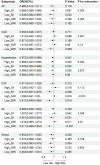Association between oxidative balance score, systemic inflammatory response index, and cardiovascular disease risk: a cross-sectional analysis based on NHANES 2007-2018 data
- PMID: 38899319
- PMCID: PMC11186475
- DOI: 10.3389/fnut.2024.1374992
Association between oxidative balance score, systemic inflammatory response index, and cardiovascular disease risk: a cross-sectional analysis based on NHANES 2007-2018 data
Abstract
Background: There is limited research on the relationship between Systemic Oxidative Stress (SOS) status and inflammatory indices. Adding onto existing literature, this study aimed to examine the association between dietary Oxidative Balance Score (OBS) and lifestyle OBS (which make up the overall OBS), and Cardiovascular Disease (CVD) prevalence at different Systemic Immune Inflammation Index (SII) and Systemic Inflammatory Response Index (SIRI) levels.
Methods: This study involved 9,451 subjects selected from the National Health and Nutrition Examination Survey (NHANES) 2007-2018. The OBS comprised 20 dietary and lifestyle factors. Statistical methods included Weighted Linear Regression Analysis (WLRA), Logistic Regression Analysis (LRA), Sensitivity Analysis (SA), and Restricted Cubic Spline (RCS) analysis.
Results: The multivariate WLRA revealed that OBS was significantly negatively correlated with both SII (β = -5.36, p < 0.001) and SIRI (β = -0.013, p < 0.001) levels. In SA, removing any single OBS component had no significant effect on the WLRA results of SII and SIRI. Further subgroup analyses revealed that OBS was more impactful in lowering SII in women than in men. Additionally, OBS was more significantly negatively correlated with SII and SIRI in the low-age group than in the high-age group. Moreover, RCS analysis confirmed this linear relationship. Compared to dietary OBS, lifestyle OBS exerted a more significant effect on Coronary Artery Disease (CAD) (OR: 0.794, p = 0.002), hypertension (OR: 0.738, p < 0.001), Congestive Heart Failure (CHF) (OR: 0.736, p = 0.005), Myocardial Infarction (MI) (OR: 0.785, p = 0.002), and stroke (OR: 0.807, p = 0.029) prevalence. Furthermore, SIRI exhibited a significant interaction in the relationship between overall OBS, dietary OBS, and CHF (P for interaction < 0.001). On the other hand, SII had a significant interaction in the relationship between overall OBS, dietary OBS, and MI (P for interaction < 0.05).
Conclusion: OBS, including lifestyle and dietary OBS, were significantly negatively associated with SII and SIRI. Higher lifestyle OBS was associated with reduced risks of CAD, hypertension, CHF, MI, and stroke.
Keywords: CVD; NHANES; OBS; SII; SIRI.
Copyright © 2024 Chen, Li, Xie, Liu, Li, Mai, Lai, Wu and Zhong.
Conflict of interest statement
The authors declare that the research was conducted in the absence of any commercial or financial relationships that could be construed as a potential conflict of interest.
Figures





Similar articles
-
Higher systemic immune-inflammation index and systemic inflammation response index levels are associated with stroke prevalence in the asthmatic population: a cross-sectional analysis of the NHANES 1999-2018.Front Immunol. 2023 Aug 4;14:1191130. doi: 10.3389/fimmu.2023.1191130. eCollection 2023. Front Immunol. 2023. PMID: 37600830 Free PMC article.
-
Associations between phthalate metabolites and two novel systemic inflammatory indexes: a cross-sectional analysis of NHANES data.Ann Med. 2025 Dec;57(1):2496411. doi: 10.1080/07853890.2025.2496411. Epub 2025 Apr 24. Ann Med. 2025. PMID: 40272105 Free PMC article.
-
Association between systemic immune inflammation index, systemic inflammation response index and adult psoriasis: evidence from NHANES.Front Immunol. 2024 Feb 13;15:1323174. doi: 10.3389/fimmu.2024.1323174. eCollection 2024. Front Immunol. 2024. PMID: 38415255 Free PMC article.
-
Systemic Immune-Inflammation Index and Systemic Inflammation Response Index are Associated With Periodontitis: Evidence From NHANES 2009 to 2014.Int Dent J. 2024 Oct;74(5):1033-1043. doi: 10.1016/j.identj.2024.03.019. Epub 2024 Apr 30. Int Dent J. 2024. PMID: 38688802 Free PMC article.
-
Association of systemic immune biomarkers with metabolic dysfunction-associated steatotic liver disease: a cross-sectional study of NHANES 2007-2018.Front Nutr. 2024 Sep 4;11:1415484. doi: 10.3389/fnut.2024.1415484. eCollection 2024. Front Nutr. 2024. PMID: 39296508 Free PMC article.
Cited by
-
Association between oxidative stress and metabolic-associated fatty liver disease in the US population.Sci Rep. 2025 Jul 1;15(1):21352. doi: 10.1038/s41598-025-05044-7. Sci Rep. 2025. PMID: 40595849 Free PMC article.
-
Effects of the Interaction Between Oxidative Balance Score and Polygenic Risk Scores on Incidence of Metabolic Syndrome in Middle-Aged Korean Adults.Antioxidants (Basel). 2024 Dec 18;13(12):1556. doi: 10.3390/antiox13121556. Antioxidants (Basel). 2024. PMID: 39765884 Free PMC article.
-
Systemic Immune-Inflammatory Index as a Prognostic Biomarker in Patients with Heart Failure: A Comprehensive Analysis.Clin Appl Thromb Hemost. 2025 Jan-Dec;31:10760296251328361. doi: 10.1177/10760296251328361. Epub 2025 Mar 13. Clin Appl Thromb Hemost. 2025. PMID: 40079806 Free PMC article.
-
Association between oxidative balance score and prevalence rates of thyroid dysfunction and autoimmune thyroiditis among U.S. adults: evidence from epidemiological studies.Front Nutr. 2025 May 15;12:1592577. doi: 10.3389/fnut.2025.1592577. eCollection 2025. Front Nutr. 2025. PMID: 40444246 Free PMC article.
-
Association between oxidative balance score and gallstone disease: a population-based study from NHANES.Front Nutr. 2025 Jan 22;12:1539969. doi: 10.3389/fnut.2025.1539969. eCollection 2025. Front Nutr. 2025. PMID: 39911802 Free PMC article.
References
LinkOut - more resources
Full Text Sources
Miscellaneous

